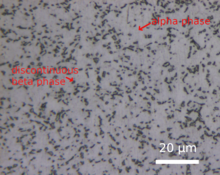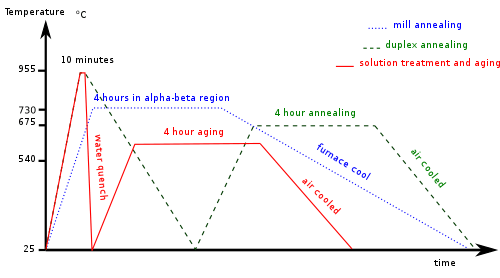Ti-6Al-4V
Ti-6Al-4V (UNS designation R56400), also sometimes called TC4, Ti64[1], or ASTM Grade 5, is an alpha-beta titanium alloy with a high strength-to-weight ratio and excellent corrosion resistance. It is one of the most commonly used titanium alloys and is applied in a wide range of applications where low density and excellent corrosion resistance are necessary such as e.g. aerospace industry and biomechanical applications (implants and prostheses).
Studies of titanium alloys used in armors began in the 1950s at the Watertown Arsenal, which later became a part of the Army Research Laboratory.[2][3]
Chemistry
(in wt. %)[4]
| V | Al | Fe | O | C | N | H | Y | Ti | Remainder Each | Remainder Total | |
|---|---|---|---|---|---|---|---|---|---|---|---|
| Min | 3.5 | 5.5 | -- | -- | -- | -- | -- | -- | -- | -- | -- |
| Max | 4.5 | 6.75 | .3 | .2 | .08 | .05 | .015 | .005 | Balance | .1 | .3 |
Physical and Mechanical Properties

Ti-6Al-4V titanium alloy commonly exists in alpha, with hcp crystal structure, (SG : P63/mmc) and beta, with bcc crystal structure, (SG : Im-3m) phases. While mechanical properties are a function of the heat treatment condition of the alloy and can vary based upon properties, typical property ranges for well-processed Ti-6Al-4V are shown below.[5][6][7] Aluminum stabilizes the alpha phase, while vanadium stabilizes the beta phase.[8][9]
| Density, g/cm3 | Young's Modulus, GPa | Shear Modulus, GPa | Bulk Modulus,GPa | Poisson's Ratio | Yield Stress, MPa (Tensile) | Ultimate Stress, MPa (Tensile) | Hardness, Rockwell C | Uniform Elongation, % | |
|---|---|---|---|---|---|---|---|---|---|
| Min | 4.429 | 104 | 40 | 96.8 | 0.31 | 880 | 900 | 36 (Typical) | 5 |
| Max | 4.512 | 113 | 45 | 153 | 0.37 | 920 | 950 | -- | 18 |
Ti-6Al-4V has a very low thermal conductivity at room temperature, 6.7 - 7.5 W/m·K[10][11], which contributes to its relatively poor machinability.[11]
Heat Treatment of Ti-6Al-4V

Ti-6Al-4V is heat treated to vary the amounts of and microstructure of and phases in the alloy. The microstructure will vary significantly depending on the exact heat treatment and method of processing. Three common heat treatment processes are mill annealing, duplex annealing, and solution treating and aging[12].
Applications
- Implants and prostheses (wrought, cast or by Solid Freeform Fabrication (SFF))[13]
- Additive Manufacturing[14]
- Parts and prototypes for racing and aerospace industry. Used extensively within the Boeing 787 aircraft.
- Marine applications
- Chemical industry
- Gas turbines
Specifications
- UNS: R56400
- AMS Standard: 4911
- ASTM Standard: F1472
- ASTM Standard: B265 Grade 5[15]
References
- Paul K. Chu; XinPei Lu (15 July 2013). Low Temperature Plasma Technology: Methods and Applications. CRC Press. p. 455. ISBN 978-1-4665-0991-7.
- "Founding of ARL". www.arl. army.mil. Army Research Laboratory. Retrieved 6 June 2018.
- Gooch, William A. "The Design and Application of Titanium Alloys to U.S. Army Platforms -2010" (PDF). U.S. Army Research Laboratory. Retrieved 6 June 2018.
- "ASTM Compass, Standard Specification for Wrought Ti-6Al-4V Alloy for Surgical Implant Applications. (UNS R56400)" (PDF). ASTM Compass.
- "Titanium Ti-6Al-4V (Grade 5), Annealed". asm.matweb.com. ASM Aerospace Specification Metals, Inc. Retrieved 14 March 2017.
- "Titanium Alloy Ti 6Al-4V Technical Data Sheet". cartech.com. Carpenter Technology Corporation. Retrieved 14 March 2017.
- "AZoM Become a Member Search... Search Menu Properties This article has property data, click to view Titanium Alloys - Ti6Al4V Grade 5". www.azom.com. AZO Materials. Retrieved 14 March 2017.
- Wanhill, Russell; Barter, Simon (2012), "Metallurgy and Microstructure", Fatigue of Beta Processed and Beta Heat-treated Titanium Alloys, Springer Netherlands, pp. 5–10, doi:10.1007/978-94-007-2524-9_2, ISBN 9789400725232
- Donachie, Matthew J. (2000). Titanium : a technical guide (2nd ed.). Materials Park, OH: ASM International. pp. 13–15. ISBN 9781615030620. OCLC 713840154.
- "ASM Material Data Sheet". asm.matweb.com. Retrieved 2020-06-20.
- Yang, Xiaoping; Liu, C. Richard (1999-01-01). "Machining Titanium and Its Alloys". Machining Science and Technology. 3 (1): 107–139. doi:10.1080/10940349908945686. ISSN 1091-0344.
- ASM Committee (2000). "The Metallurgy of Titanium". Titanium: A Technical Guide. ASM International. pp. 22–23.
- "Ti6Al4V Titanium Alloy" (PDF). Arcam.
- "Ti64 Titanium Alloy Powder". Tekna.
- "§1.1.5", ASTM B265-20a, Standard Specification for Titanium and Titanium Alloy Strip, Sheet, and Plate, West Conshohocken, PA: ASTM International, 2020, doi:10.1520/B0265-20A, retrieved 13 August 2020